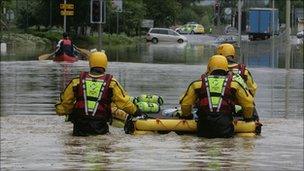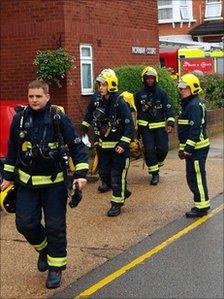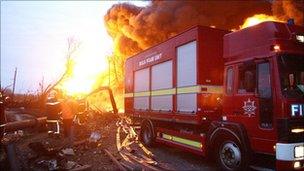Firefighters pension schemes
- Published

The scheme is the eighth largest in the UK's public sector
Which employees do the schemes cover?
Staff of the 46 fire authorities in England with equivalent schemes in Scotland, Wales and Northern Ireland.
How many sections are there?
Two. There is the 1992 Firefighters' Pension Scheme (FPS), which has been closed to new entrants since 5 April 2006, and the New Firefighters' Pension scheme (NFPS).
Some staff who work in fire control centres are members of the Local Government Pension Scheme.
How many active, deferred and retired members are there?
The communities and local government department (DCLG) says altogether there are 45,000 active members, 36,000 pensioners and 2,000 deferred members in England.
What are the principal benefits?
In the FPS there is a 2/3rds final-salary pension after 30 years.
The accrual rate is 1/60th a year for the first 20 years, then 2/60ths from years 20 to 30. The normal retirement age is 55. Early retirement at 50 is possible if 25 years or more service have been accrued.
In the NFPS there is a 2/3rds final-salary pension after 40 years.
Accrual is at a constant rate of 1/60th all the way through and a normal retirement age of 60 years. Members can in theory accrue a 45/60ths pension after 45 years.
What percentage of salary do employees and employers pay?
In the FPS employees pay 11% of salaries and employers pay about 24.4%.

The retirement age has been raised to 60 for new recruits since 2006
In the NFPS employees pay 8.5% of salaries and employers pay about 11.8%.
What are the funding costs of the scheme?
The 2007 valuation said the cost of FPS was 37.7% of pensionable salary and the cost of the NFPS was 23.7%.
The weighted combined cost was put at 36.5%, but this is expected to decline as NFPS membership increases.
The next valuation will be at March 2011.
Is the scheme funded or unfunded?
Unfunded. The benefits are paid for out of general taxation, not an underlying investment fund.
What are the value of the scheme's assets, if any, and its liabilities?
Liabilities were put at £13.8bn by the Government Actuary's Department (GAD) in 2007.
What is the average pension in payment?
£12,000 a year.
Have there been any changes or reforms to the scheme in recent years?
The main one was the closure of the old scheme in 2006 and its replacement with the NFPS. The Fire Brigades Union (FBU) says other changes have been:

The FBU has argued that later retirement will lead to an older, less fit, workforce
1) New ill-health provisions introduced, cutting ill-health retirements down to around 1.2 per 1000 from around 17.7 per 1000 in 2001.
2) Two-tier ill-health provision.
Are there any further changes in the pipeline?
The government intends to revalue pensions in payment in line with inflation as measured by the consumer prices index (CPI) rather than the retail prices index (RPI).
Various other suggestions include raising retirement ages, increasing contributions, and closing the FPS entirely, says the FBU.
Source: FBU. Government Actuary's Department. DCLG.